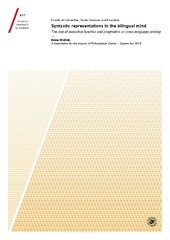Syntactic representations in the bilingual mind: the role of executive function and pragmatics in cross-language priming
Permanent link
https://hdl.handle.net/10037/8275Date
2015-12-10Type
Doctoral thesisDoktorgradsavhandling
Author
Wolleb, AnnaAbstract
In this thesis I investigate how syntactic forms are represented and accessed in the mind of bilingual children. In particular, I explore the role of executive control and pragmatics in the selection and use of these representations. To do so, I tested a group of Norwegian-English bilingual children and a group of Norwegian age-matched monolinguals in a priming paradigm and in a cognitive task (the Dimensional Change Card Sort, hereafter DCCS). I investigated word order in possessive constructions and dative alternation. These forms were chosen because they allow for different word orders, which vary depending on semantic and discourse factors. That is, the different structures were elicited by means of a priming task (both within- and between-language) where children were first exposed to the alternating word orders (prime) and then had to describe a picture by selecting one the two possible options (target). My goals are two-fold: first, to show that priming within-language is stronger than priming between-language, arguably due to the involvement of an inhibitory mechanism; second, to demonstrate that the access to the abstract syntactic representation is mediated by semantic and pragmatic factors.
Publisher
UiT Norges arktiske universitetUiT The Arctic University of Norway
Metadata
Show full item recordCollections
Copyright 2015 The Author(s)
The following license file are associated with this item:


 English
English norsk
norsk
